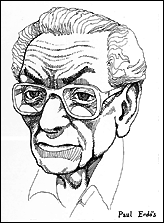Mike McBeath - Erdös Number 5
 Paul
Erdös (pronounced AIR-dish), a Hungarian-American mathematician, was
the most
prolific mathematician of the 20th century (~1500 papers),
and he
collaborated with many others (~500 co-authors). His
co-authors are designated as having an Erdös number of
1, their co-authors an Erdös numbers of 2, and so on. Einstein
has an Erdös numbers of 2 and
Piaget of 3, while mine is 5. Below is my
Erdös lineage with cited articles and notes. Probably
the most famous person with an
Erdös number of 1, at least by some accounts, is baseball legend and
home run
king, Henry Aaron. How, might one
ask, did the eccentric Hungarian mathematician hook up with the
non-academic
African-American athlete? In 1995,
both were awarded honorary degrees from Emory University, and ended up
signing
the same baseball.
Paul
Erdös (pronounced AIR-dish), a Hungarian-American mathematician, was
the most
prolific mathematician of the 20th century (~1500 papers),
and he
collaborated with many others (~500 co-authors). His
co-authors are designated as having an Erdös number of
1, their co-authors an Erdös numbers of 2, and so on. Einstein
has an Erdös numbers of 2 and
Piaget of 3, while mine is 5. Below is my
Erdös lineage with cited articles and notes. Probably
the most famous person with an
Erdös number of 1, at least by some accounts, is baseball legend and
home run
king, Henry Aaron. How, might one
ask, did the eccentric Hungarian mathematician hook up with the
non-academic
African-American athlete? In 1995,
both were awarded honorary degrees from Emory University, and ended up
signing
the same baseball.
Note of Interest: Paul Erdös’s sense of humor was exemplified in
his quote,
“Mathematicians are a device for turning coffee into theorems.”
1. First
Link (Paul Erdös to Ralph Phillip Boas, Jr.):
Boas, R. P., Jr., Buck, R. C. & Erdös, P. (1948) The set on which an entire function is small. American Journal of Mathematics, 70, 400-402.
Note of interest: Boas, longtime Math Dept chair at
Northwestern, is also credited with having published a widely
disseminated humorous
article under a pseudonym: Petard,
H. (1938). A contribution to the
mathematical theory of big game hunting. The
American Mathematical Monthly, 45 (7,
Aug-Sep), 446-447.
2. Second Link (Ralph
Phillip Boas, Jr. to John Wilder Tukey):
Boas, R. P., Jr. & Tukey, J. W. (1938). A note on linear functionals. Bulletin of the American Mathematics Society, 44, 523-528.
Note of interest: This was the eminent statistician,
John Wilder Tukey’s, first publication. Tukey
published a second paper with Boas in 1940, and
acquired another link to Erdös via an article published in 1942 with
mathematician Arthur Harold Stone. While
at Princeton, a group comprised of Tukey, Boas, and
others concocted a pseudonymous mathematician named E.S. Pondiczery
from Ong’s
Hat NJ, who was the identity that submitted the Petard paper, and who
later
published an article and numerous reviews, often humorous.
3. Third Link (John
Wilder
Tukey to J. J. Chang):
Atal, B. S., Chang, J.J., Mathews, M. V., & Tukey, J. W. (1978). Inversion of articulatory-to-acoustic transformation in the vocal tract by a computer-sorting technique. Journal of the Acoustical Society of America, 63, 1535-1555.
Note of
interest: This is the only paper Tukey
published
with Chang. All of the authors
were members of the Bell Research Laboratory, where acclaimed Cognitive
Psychologist, Roger N. Shepard, the fourth link below, worked during
the late
1950s and 1960s. Shepard and
Mathews both ended up coming to Stanford University.
Shepard, R. N. & Chang, J. J. (1963). Stimulus Generalization in learning of classifications. Journal of Experimental Psychology, 65(1), 94-102.
Note of Interest:
Like, Ralph Boas, Roger Shepard
also demonstrated playfulness with editors. 17
years after publishing his most widely cited paper:
[Shepard, R. N. & Metzler, J. (1971), Mental rotation of
3-dimensional
objects, Science , 171(3972),701-703.], another publication by
Shepard
and Metzler appeared on the same topic. To the consternation of
future
bibliographers everywhere, it turns out the second paper was written by
two
entirely different authors, Shena Shepard and David Metzler, Roger’s
daughter
and an unrelated accomplice who Roger had arranged to work with her
[see Journal
of Experimental Psychology: Human Perception and Performance, 14(1),
3-11, 1988].
5. Fifth
Link (Roger N. Shepard to Michael K. McBeath):
McBeath, M. K. & Shepard, R. N. (1989). Apparent motion between shapes differing in location and orientation – A window technique for estimating path curvature. Perception & Psychophysics, 46(4), 333-337.
Note of Interest: Roger Shepard was my
graduate advisor, and this was my first
mainstream Psychology publication. Continuing
in the tradition of prankster articles, it turns
out that my actual first publication, while still an undergraduate a
decade
earlier, was one in which I described a litany of college pranks that I
helped
orchestrate. It was published in
an obscure journal called Learning Today. Since
I remain unsure how long the statute of limitations
extends on these kinds of activities, I shall leave it up to the
detective
ability of others to try and locate this reference. As
far as I am aware, it has never been cited.
|
|
¦
¦
|
|
¦
¦
|
|
¦
¦
|
|
¦
¦
|
|
¦
¦
|
|
¦
¦
|
John G.
Jewell, Mary K. Kaiser, Scott Krauchunas, Sean Lane,
Clifford F.
Lewis, Sean Madigan, Karen H. McBeath, Eric Metz,
Shannon
Morgan, Kazunori Morikawa, Keshav Mundhra, John G. Neuhoff, Susan
Perry, Peter R. Phillips, Windy Roy, Angelique A. Scharine,
Diane J.
Schiano, Mark Shafer, Dennis M. Shaffer, Roger N. Shepard, Thomas G.
Sugar, Anthony Suluh, Yukari Takari, Michael A. Thalbourne, Barbara
Tversky, W. C. Wanne, Zheng Wang, Joseph Wayand,
Kristel Zachow |